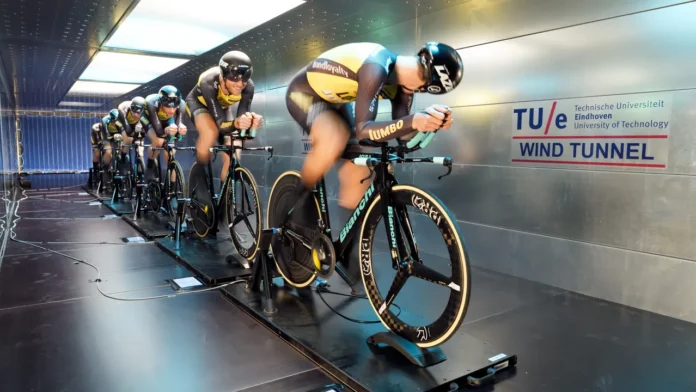The Jumbo-Visma cycling team has written Dutch sports history by winning the Tour de France this weekend. TU/e professor Bert Blocken had a part in this victory.
Blocken has been associated with the cycling team since 2017 as an aerodynamics advisor. The wind tunnel at the TU/e served to provide the celebrated cyclists with as little resistance as possible from wind and air.
Incidentally, it is not the first time that Blocken contributed to sporting success. Previously, he helped Kenyan marathon runner Eliud Kipchoge become the first person ever to run the marathon in less than two hours.
Jonas Vingegaard, Wout van Aert, Christophe Laporte, Primoz Roglic have all made their appearance in Eindhoven in recent years. The riders got what they were looking for in Eindhoven. Namely useful advice about posture, position in the group, cycling and clothing, everything to save as much time as possible.
Puzzle Pieces
Blocking, however, remains modest. According to him, aerodynamics is “one of the many puzzle pieces in the success of this team. But the biggest puzzle piece is of course the riders themselves. When all the pieces of the puzzle fall into place, it can lead to great results.”
In addition to the wind tunnel tests, extensive computer simulations were also part of Blocken’s work. For example, the professor advised riders to raise their hands and forearms more on the time trial handlebars.
“That shields the face and is, therefore, better aerodynamically. You now see that all good time trialists are copying this.” The result of the time trial that was held on Saturday is significant: Jumbo-Visma cyclists Wout van Aert and Jonas Vingegaard were first and second respectively.
Trailers
The professor also has an impact on cycling in other areas. In 2015, Blocken showed that a support vehicle driving right behind a cyclist saves a lot of time because the car pushes the air forward, and with it the rider. This not only unfair but also dangerous. “You now see that some teams use a van as a support vehicle because they have a greater effect than a smaller passenger car. This stems directly from our research.”
Gain
Although Blocken has contributed to the success of the cycling team with the necessary innovations, he believes that there is still a lot to gain. “This is certainly not the end of aerodynamic innovations in cycling. The complexity of aerodynamics, combined with the many variables in cycling, will yield decades of scientific innovations, and important seconds of time savings.”
Source:Studio040
Translate: Ayşenur











